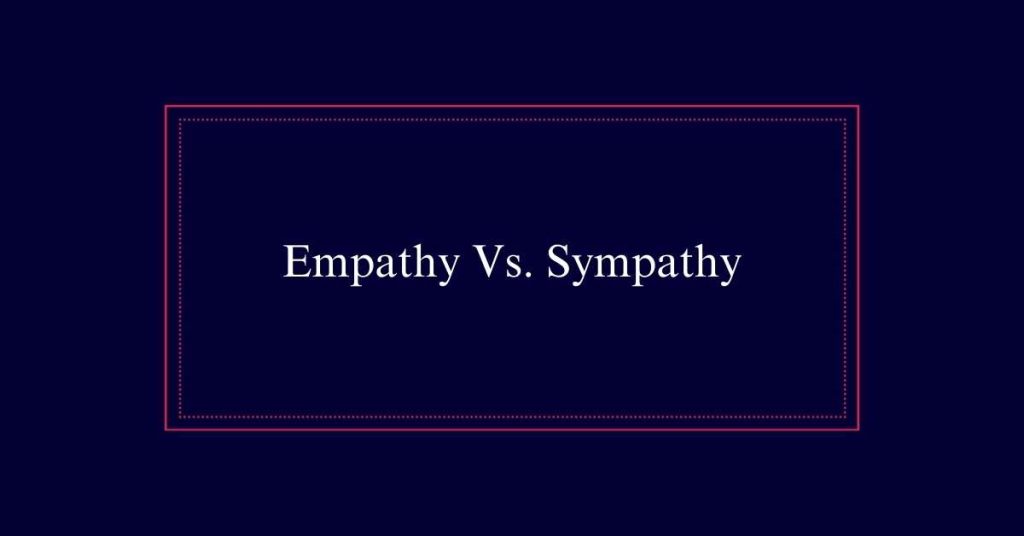Empathy Vs. Sympathy
Empathy and sympathy both involve connecting with others’ emotions, but they differ in depth. Sympathy, originating from Greek ‘syn’ and ‘pathos,’ involves sharing and expressing concern for others’ suffering, like sending a sympathy card. Empathy, a more recent concept from 20th-century psychology, involves deeply understanding and sharing another’s emotional experience.
Empathy requires immersing oneself in another’s perspective, fostering stronger emotional connections, effective communication, and conflict resolution. While sympathy shows care from a distance, empathy takes an active, participatory role in understanding.
Origins of Sympathy
Sympathy originates from the Greek words ‘syn’ meaning ‘with’ and ‘pathos’ meaning ‘feeling.’ This term describes the act of sharing in someone’s emotional experiences, particularly their sorrows or troubles.
Unlike empathy, which involves understanding another’s emotions from their perspective, sympathy is about feeling concern or sorrow for someone else’s plight. It often manifests in actions like sending sympathy cards to grieving individuals.
Additionally, sympathy can indicate harmony in tastes or opinions and support for causes or individuals. It encompasses emotions of approval, loyalty, or support, reflecting a connection to others’ emotional states.
Origins of Empathy
Empathy, a relatively modern term, originates from the Greek words ‘en’ meaning ‘in’ and ‘pathos’ meaning ‘feeling.’ This concept has evolved to describe the ability to understand and share the emotions of others. Unlike sympathy, which involves sharing someone else’s feelings, empathy involves placing oneself in another’s shoes.
Key aspects of empathy’s origins include:
- Historical Development: Emerged prominently in psychological literature in the 20th century.
- Philosophical Roots: Influenced by theories of emotional resonance.
- Scientific Studies: Explored extensively in neuroscience and psychology.
- Cultural Impact: Widely recognized in both Western and Eastern philosophies.
Greek Root ‘Pathos’
The Greek root ‘pathos’ is fundamental to understanding the emotional dimensions associated with both empathy and sympathy. Derived from the Greek word for ‘suffering’ or ‘experience,’ ‘pathos’ forms the basis for these terms, linking them to the domain of emotions.
| Term | Meaning |
|---|---|
| Pathos | Greek root meaning ‘suffering’ or ‘experience’ |
| Sympathy | Sharing someone else’s sorrow or troubles |
| Empathy | Understanding and sharing another’s experiences |
Sympathy involves feeling pity or sorrow for someone else’s troubles. Empathy, on the other hand, goes deeper. It entails actively understanding and sharing the feelings and experiences of another person.
Emotional Sharing
Emotional sharing involves connecting with another person’s feelings and experiences. It is a fundamental aspect of both empathy and sympathy, yet it manifests differently in each.
Emotional sharing in empathy means deeply understanding and experiencing another’s emotions. In sympathy, it translates to feeling concern for another’s distress without necessarily experiencing it yourself.
Key aspects of emotional sharing include:
- Active listening: Paying close attention to what the other person is saying.
- Non-verbal cues: Recognizing body language and facial expressions.
- Emotional resonance: Feeling a similar emotional response.
- Verbal acknowledgment: Expressing understanding through words.
Understanding Experiences
Understanding experiences involves recognizing and interpreting the emotions and situations that others go through. This requires a conscious effort to listen and observe. One must pay attention to verbal cues, body language, and context.
This practice goes beyond surface-level interactions. It means immersing oneself in another’s perspective, acknowledging their feelings, and validating their experiences. This depth of understanding fosters genuine connections and trust. It is essential for effective communication and conflict resolution.

Empathy, in particular, hinges on this skill, as it allows individuals to relate to others on a deeper level.
Sympathy in Practice
How can we effectively practice sympathy in our daily interactions?
Sympathy involves acknowledging another person’s feelings, especially in times of trouble. Practicing sympathy helps build connections and provides comfort to those in distress.
Here are some practical ways to incorporate sympathy into your daily life:
- Listen actively: Give your full attention to the person, showing that you care about their feelings.
- Express concern: Use kind words to show that you understand and share their sorrow.
- Offer support: Provide tangible help, like running errands or offering a shoulder to cry on.
- Send thoughtful notes: A handwritten card or message can convey your sympathy in a heartfelt way.
Empathy in Action
While sympathy is vital for offering comfort, empathy allows us to truly connect by sharing and understanding another person’s experiences and emotions. Empathy in action means actively listening, being present, and responding to others’ feelings. It can be practiced in various settings like workplaces, families, and social interactions.
| Scenario | Empathy Response | Impact |
|---|---|---|
| Workplace | Listening to a colleague’s stress | Builds trust and support |
| Family | Understanding a child’s frustration | Strengthens emotional bonds |
| Social Situations | Recognizing a friend’s sadness | Enhances mutual understanding and connection |
Literary Illustrations
Literature often provides vivid examples of empathy and sympathy through its characters and narratives. These emotional connections are essential in understanding human experiences.
- To Kill a Mockingbird: Atticus Finch’s empathy towards Tom Robinson highlights racial injustice.
- Les Misérables: Jean Valjean’s sympathy for Fantine showcases societal compassion.
- Of Mice and Men: George’s empathy for Lennie underscores deep personal bonds.
- A Christmas Carol: Scrooge’s transformation from indifference to empathy reveals the power of human connection.
These works demonstrate how empathy and sympathy shape characters’ actions and decisions. They help readers understand different perspectives and foster emotional awareness. Through literature, these concepts become more relatable and impactful, allowing readers to connect deeply with the stories and characters.
Educational Importance
Understanding empathy and sympathy through literature underscores their educational importance in developing emotional intelligence and interpersonal skills. These concepts are essential in creating a nurturing learning environment. They help students connect with others’ experiences, fostering inclusivity and understanding.
Empathy encourages students to see the world from different perspectives, enhancing critical thinking and problem-solving abilities. Sympathy, on the other hand, promotes compassion and support within the classroom. Integrating empathy and sympathy into education helps build a more emotionally aware generation. It prepares students to handle interpersonal relationships effectively.
Communication Tools
Effective communication tools are essential for fostering empathy and sympathy in both personal and professional interactions. These tools help in expressing and understanding emotions, which strengthens relationships and collaboration.
- Active Listening: Pay full attention to the speaker, acknowledge their feelings, and respond thoughtfully.
- Nonverbal Cues: Use body language, facial expressions, and eye contact to show understanding and concern.
- Reflective Statements: Paraphrase what the other person says to confirm understanding and show empathy.
- Open-Ended Questions: Encourage deeper conversation and allow the speaker to share more about their experiences.
Frequently Asked Questions
How Can Empathy Improve Personal Relationships?
Empathy improves personal relationships by fostering deeper understanding and connection. By genuinely sharing and comprehending another’s feelings, individuals build trust, enhance communication, and create stronger, more supportive bonds within their relationships.
Can Sympathy Lead to Burnout?
Yes, sympathy can lead to burnout. Constantly sharing others’ sorrows and distress can be emotionally draining. Over time, this emotional toll can result in feelings of exhaustion, detachment, and decreased ability to empathize or provide support.
How Does Empathy Differ in Virtual Interactions?
Empathy in virtual interactions differs by lacking physical cues and immediate feedback. It relies more on verbal communication and digital signals, which can make understanding emotions and experiences more challenging compared to face-to-face interactions.
What Role Does Culture Play in Expressions of Sympathy?
Culture profoundly influences how sympathy is expressed. Different cultures have unique customs, traditions, and rituals for showing support and sharing emotions, such as mourning practices, communication styles, and social expectations during times of sorrow.
Are There Psychological Benefits to Practicing Empathy?
Practicing empathy provides psychological benefits, including improved emotional regulation, stronger relationships, and greater overall well-being. By understanding others’ experiences, individuals can foster deeper connections and reduce feelings of loneliness and isolation.






